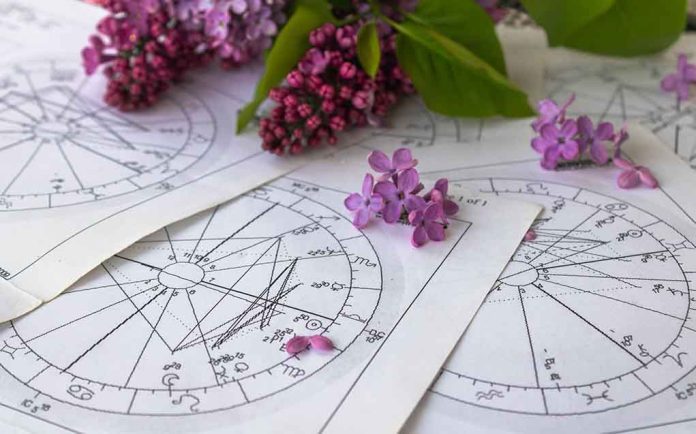
The planets and signs live in… houses. That’s right. Just like YOU.
You may have heard of your Rising Sign, or ascendant in astrology. Your Rising Sign is actually the sign on the cusp of the first house in your natal chart. Houses are important in astrology, and you wouldn’t be able to get a full astrological reading without them.
Let’s chat a little more deeply about what this all means.
What ARE Astrological Houses?
Western Tropical astrology has 12 houses in each natal chart. Each house represents a place or area of your life, just like a real house. In your natal chart, they are extended into space, superimposed on the ecliptic and the signs, most often from exactly the time and place of your birth.
In most house systems, the first house cusp (or Ascendant or ASC) is where the east horizon was at the moment of your birth. The cusp of the tenth house (the MidHeaven or MC) is what was above you at the top of the chart. The seventh house cusp would be the point on the western horizon (also known as the descendant or DC). The fourth house cusp is at the bottom of your chart and is called the Imum Coeli or IC. From there, the rest of the 12 houses are calculated.
The Basic History and Evolution of Astrological Houses
Houses have been used in astrology since before antiquity. We don’t know who originally came up with this process, but we do know that houses may have been used in astrology as far back as ancient Greece. While what kind of house system they used was different to what we may use today, they laid a foundation that has been calculated and recalculated by astrologers ever since.
Over time, many house systems have come in and out of fashion, but many early houses are still being used today, all with their strengths and weaknesses. For example, some astrologers in the United States like the Equal House system for its simplicity and its roots in the Whole Sign House system.
The Whole Sign House system is what may have spawned the Equal House system. This early system, that we can trace as far back as early Greek and Roman astrologers, is still used widely. It is used extensively in India as well as by other traditional eastern and western astrologers. This house system starts at zero degrees of the sign that the ascendant is in, and encapsulating each subsequent sign in each 30 degree house, so that the ascendant and midheaven float in the house of their sign. Many contemporary Hellenistic astrologers will use this early method side by side with a quadrant house method.
The Equal House system sees each house as exactly 30 degrees and measures that out directly from the ascendant, all around the natal chart, making it simple and useful (for the most part), especially for beginners. However, it isn’t entirely accurate for properly calculating the MidHeaven. It often moves the MC off of the 10th house cusp, perhaps rendering less than a complete and accurate interpretation of a natal chart. So, what it has on other house systems in simplicity, it lacks in nuance. There is an MC-first version of this system, too, but then, as expected, the ascendant doesn’t end up on the first house cusp.
Astrologers have come up with various other house systems to try to fix these problems for a few thousand years. Still, both of these methods have their place and value in both history and in practice.
Popular House Systems
Placidus
The most popular house system used by western astrologers is called Placidus, named after mathematician and astrologer Placidus de Titis in the 1600s, but may have been around much longer than that. Placidus gets the credit and the clout, most likely because the Catholic church liked his geocentric theories, but this house system has also been tied to a slightly earlier astrologer named Giovanni Antonio Magini. Some contend it may have gone even further back than Magini.
This house system is considered to be one of the most accurate, as long as you were born and live between the latitudes of 66°S and 66°N on planet Earth. If you live closer than that to the poles, the house calculations get skewed.
Even in places where the latitude is within the accurate area, this house system can have something called intercepted houses (also known as interceptions). In this case, houses can be smaller than 15 degrees, having more than one house ruled by a sign — or greater than 30 degrees, having a sign completely embedded in a house and then not having a house to “rule.”
Astrologers will argue (after all, that’s what we do best) whether this is a limitation or a feature. Some astrology enthusiasts will feel that this is simply inaccurate and overwhelming. Other astrologers feel that this adds a deeper meaning and even more nuance to an individual natal chart and will take that into account when reading the chart from a psychological standpoint.
One of the other views on this house system is that it only became popular in the western world because the tables for casting the charts by hand were the only ones translated into English in the 18th century. The availability of this system for calculation was what led to the popularity, rather than actual accuracy.
Koch
The Koch house system is young in comparison to many others out there, as it was created in the 20th Century. It is much like Placidus in that it is based on location and temporal time for accuracy, and thus also carries the same polar limitations and interceptions. However, its basis of right ascension and equal quadrants is awesome. It can be used for calculating horoscopes (this is the house system used for creating Astrovibe horoscopes!), for research and locational astrology, and you can know that your chart’s ascendant, descendant, IC and MC are pretty accurate.
Porphyry
For people who like the Equal House system but get a case of the icks from the intercepted houses in Placidus and Koch, we offer you the Porphyry system. This house system from antiquity checks all the boxes, and that’s why it has survived since around the second century. Porphyry is our oldest-known quadrant system from around 200 AD. It places the four points properly on the first, fourth, seventh and tenth, but then distributes the other houses equally between them, lessening the chances for interceptions. That’s a win-win for people who like Equal House but want more specifics on the quadrants, too.
Other Astrological House Systems
Some others that you can dive into are called:
- Regiomontanus
- Meridian
- Campanus
- Carter
- Krusinski/Pisa/Goelzer/Amphora
- Pullen Sinusoidal Delta
- Sripati
- Morinus
- Topocentric
- Polich-Page
There are even more than those in this non-exhaustive list, but that should keep you busy for at least a little while. As time goes by, astrology evolves, grows and changes along with how we as humans grow and change. People come up with new ideas, try to improve on the old, sometimes make mistakes and then try again.
Different house systems are great for different kinds of astrology. Yes, there are many different kinds of astrology such as Psychological, Locational, Horary, Electional, and more. Each house system has pluses and minuses, and each may be better for different kinds of charts.
What Do The Astrological Houses Mean?
Now we’re getting to the fun part. So, grab the coffee, wake back up, and get comfy.
Each house, as mentioned above, represents some area of your life. Think of astrology as a language. The houses are the nouns or the where, the signs are the adjectives or the description, the planets are the verbs or the action, and the aspects are the conjunctions — like and/or. Reading a chart, then, is like translating it into sentences. Knowing the houses help us start to understand which areas of life things will play out.
Keep in mind that while we will list the traditional planet and sign rulers of the houses below, your chart will have house rulers specific to your natal chart, too.
- The first house represents the physical body and the outward personality. The sign on the first house cusp is the Rising sign or ascendant. It is ruled by Aries and Mars.
- The second house represents money, values, possessions and self-worth. It is ruled by Taurus and Venus.
- The third house represents communication, intelligence, siblings, local travel, and close neighbors. It is ruled by Gemini and Mercury.
- The fourth house represents the mother (or nurturing parent), the home, comfort, and where you begin life. It is ruled by Cancer and the Moon, and the sign on the cusp rules the IC in your chart.
- The fifth house represents art, romance, children, creativity, gambling, and entertainment. It is ruled by Leo and the Sun.
- The sixth house represents health, jobs, routine, pets, service to other people or issues and strength. It is ruled by Virgo and Mercury.
- The seventh house represents relationships, partnerships, marriage, and diplomacy. It is ruled by Libra and Venus. The sign in your chart that hits your seventh house cusp is your descendant.
- The eighth house represents birth, death, regeneration, transformation, intimacy, taxes and other people’s money. It is ruled by Scorpio and Pluto.
- The ninth house represents higher education, philosophy, long travel, expansion, ethics, luck, religion, and exploration. It is ruled by Sagittarius and Jupiter.
- The tenth house represents career, ambition, the father (or paternal parent), and motivation. It is ruled by Capricorn and Saturn, and the sign that hits your tenth house cusp is your MC or MidHeaven.
- The eleventh house represents friends, groups, communities, charities, and where you belong. It is ruled by Aquarius and Uranus.
- The twelfth house represents dreams, the unconscious, intuition, prisons and institutions, seclusion, addictions, and the occult. It is ruled by Pisces and Neptune.
The Four Quadrant Points
Now, here on Astrovibe we have two articles about the Ascendant or Rising signs already. We won’t get too far into that other than to say that the sign that sits on your first house cusp at the time you were born is your Rising Sign, and that tells you a lot about how other people experience you. To learn more, start with Rising Signs and the Masks We Wear, then dig a little deeper with The Quick and Dirty Rising Sign Guide to learn how to figure out your ascendant by hand!
The IC, or Imum Coeli, is the sign that sits on the firth house cusp at the bottom of your chart. It represents where you come from, your ancestors, your early life, and where you are coming from in life. Knowing where we are coming from can sometimes open up our minds to understand what we already know (and must learn or unlearn) on our journey toward growth.
The Descendant is the sign on your seventh house cusp. It tells you what you like in other people and the kinds of things that might make a good partner for you. BUT, being mindful about this information is essential, because it can sometimes show what we project onto other people or when we see only what we want to see.
The MidHeaven or MC is at the top of your chart on the tenth house cusp. This is how you are perceived in the public eye. It is your reputation and status. It is every bit as important as the Rising Sign for understanding how the world sees you, and is totally underrated when learning about astrology.
A Few Words About the Word Cusp
The zero degree line between houses is called a cusp. An imaginary line between Sun signs is not really a thing. One sign ends and another begins. The signs can be split into sections called decans, which is a whole other conversation. but they don’t actually have cusps. In the 1970s, the idea of Sun signs having cusps was made up to make newspaper horoscopes more understandable and easy to consume for the average reader. Being born near the time the Sun changes from one sign to the next doesn’t put you “on the cusp” of anything. That was all made up to simplify astrology, using the house term “cusp,” and nothing more. There is always something else in the natal chart that can reflect why someone “feels” like a Sun sign or not. The more you know!
Copyright 2024 Astrovibe.com


















